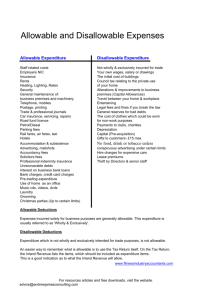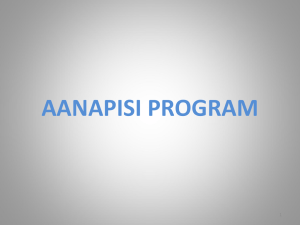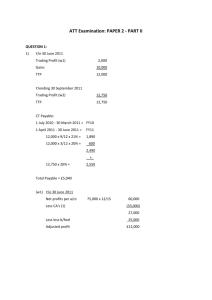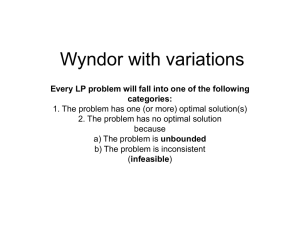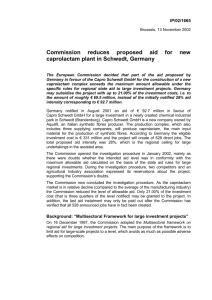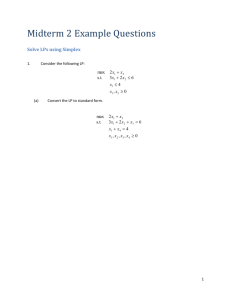Word document
advertisement
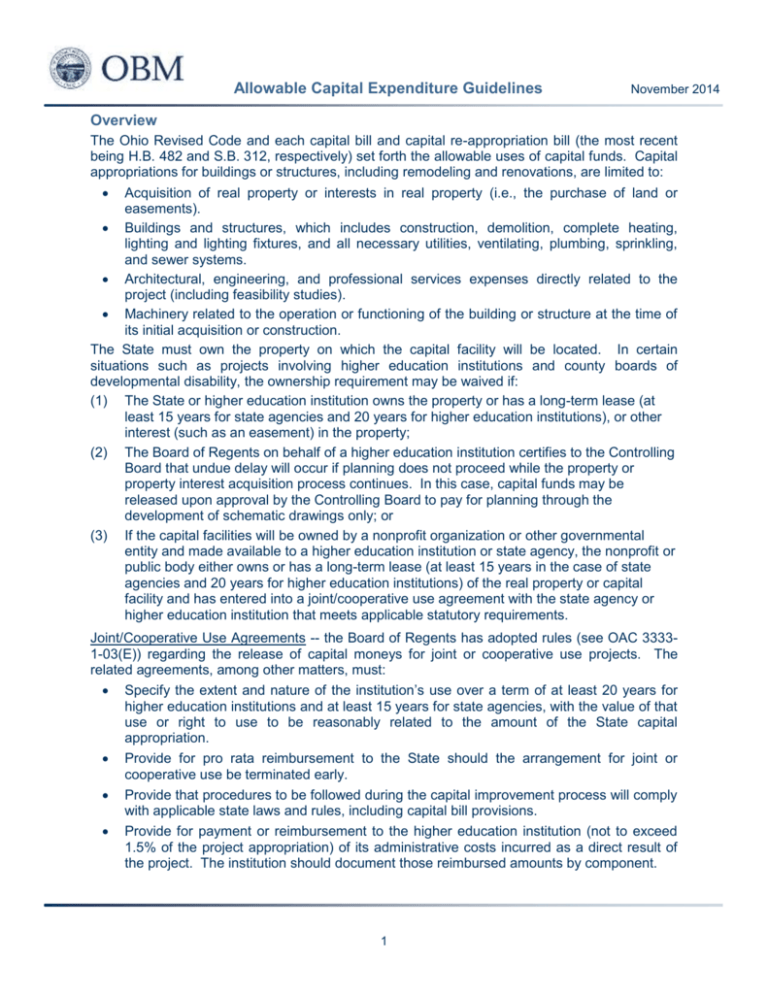
Allowable Capital Expenditure Guidelines November 2014 Overview The Ohio Revised Code and each capital bill and capital re-appropriation bill (the most recent being H.B. 482 and S.B. 312, respectively) set forth the allowable uses of capital funds. Capital appropriations for buildings or structures, including remodeling and renovations, are limited to: Acquisition of real property or interests in real property (i.e., the purchase of land or easements). Buildings and structures, which includes construction, demolition, complete heating, lighting and lighting fixtures, and all necessary utilities, ventilating, plumbing, sprinkling, and sewer systems. Architectural, engineering, and professional services expenses directly related to the project (including feasibility studies). Machinery related to the operation or functioning of the building or structure at the time of its initial acquisition or construction. The State must own the property on which the capital facility will be located. In certain situations such as projects involving higher education institutions and county boards of developmental disability, the ownership requirement may be waived if: (1) The State or higher education institution owns the property or has a long-term lease (at least 15 years for state agencies and 20 years for higher education institutions), or other interest (such as an easement) in the property; (2) The Board of Regents on behalf of a higher education institution certifies to the Controlling Board that undue delay will occur if planning does not proceed while the property or property interest acquisition process continues. In this case, capital funds may be released upon approval by the Controlling Board to pay for planning through the development of schematic drawings only; or (3) If the capital facilities will be owned by a nonprofit organization or other governmental entity and made available to a higher education institution or state agency, the nonprofit or public body either owns or has a long-term lease (at least 15 years in the case of state agencies and 20 years for higher education institutions) of the real property or capital facility and has entered into a joint/cooperative use agreement with the state agency or higher education institution that meets applicable statutory requirements. Joint/Cooperative Use Agreements -- the Board of Regents has adopted rules (see OAC 33331-03(E)) regarding the release of capital moneys for joint or cooperative use projects. The related agreements, among other matters, must: Specify the extent and nature of the institution’s use over a term of at least 20 years for higher education institutions and at least 15 years for state agencies, with the value of that use or right to use to be reasonably related to the amount of the State capital appropriation. Provide for pro rata reimbursement to the State should the arrangement for joint or cooperative use be terminated early. Provide that procedures to be followed during the capital improvement process will comply with applicable state laws and rules, including capital bill provisions. Provide for payment or reimbursement to the higher education institution (not to exceed 1.5% of the project appropriation) of its administrative costs incurred as a direct result of the project. The institution should document those reimbursed amounts by component. 1 Allowable Capital Expenditure Guidelines November 2014 Allowable Equipment and Furnishings To be financed with capital funds, expenditures for equipment or furnishings that are part of a broader project or facility must meet all of the following criteria: Essential in bringing the facility up to its intended use and necessary for the facility to function. The equipment or furnishing must be an integral part of or directly related to the basic purpose or function of the facility. Have a unit cost of at least $100. Have a useful life of at least five years. Used primarily in the rooms or areas covered by the financed project. Allowable equipment and furnishings would include computers and computer peripherals, workstations, lab and research equipment, desks, chairs, tables, bookshelves, file cabinets, carpeting/flooring, blinds, and curtains provided that they satisfy all of the above criteria. An appropriation item specifically for equipment is allowable provided the equipment meets the above unit cost and useful life provisions. Non-Allowable Equipment and Furnishings Not integral to the broader project or the facility’s intended use. Motor vehicles of any kind (e.g., cars, trucks, modified vehicles). General supplies and low-cost equipment (unit cost of less than $100). In most cases, equipment or furnishings being purchased as part of regular maintenance is not appropriate for capital funding. Consumable supplies and low-cost equipment such as fuel, oil, adding machines, calculators, trash cans, common tools, paper stock, staplers, tape dispensers, etc. are not eligible uses of capital funds. Maintenance/Repairs versus Renovations Maintenance and repairs, including maintenance contracts, are not eligible to be paid from capital funds and, thus, must be covered by operating funds. Maintenance includes a recurring activity necessary to maintain the operation, functionality, appearance or safety of a piece of equipment, building or structure. Repairs are maintenance projects that fix a known problem and do not extend the original useful life of an asset. Maintenance and repairs generally include any project with the objective of returning or restoring an item back to its original intended use or state. Examples of maintenance and repairs include: fixing a part or component of the heating or cooling system, fixing a leaky pipe, patching an interior or exterior wall, repainting, sealing windows or floors, mold remediation, glass replacement, resetting exterior walkways, replacing roofing shingles to fix a leak, and fixing tables or chairs. Renovations are more extensive enhancements, upgrades, or replacements of buildings or structures or systems and are an appropriate use of capital funds. Examples include replacing an essential component of the heating or cooling system, renovations of classrooms or other space into computer or research laboratories, upgrading electrical equipment or plumbing system components, replacing a roof, demolition, replacing carpet, painting as part of new construction or a renovation, upgrading a building’s security or automation system, and replacing stairs or walkways to meet ADA standards. 2 Allowable Capital Expenditure Guidelines November 2014 Leases, Lease-Purchase, and Installment Purchases Leases and lease-purchases of vehicles or equipment are not allowable capital expenditures. Installment purchases while not strictly prohibited are generally not approved as allowable capital expenditures. INFORMATION TECHNOLOGY (IT) SYSTEM PROJECTS Capital funds may be used to support the acquisition, development, deployment or integration (including project management) of information technology systems that constitute or are an integral part of approved capital projects. Capital funds may not be used to support the ongoing operation and maintenance of such projects. ALLOWABLE Hardware Capital funds may be used to purchase computers (including personal computers) and related peripherals such as servers, mainframes, printers, scanners, fax machines, etc. Software Software development and design (akin to facility design and engineering). Purchases of packaged “off-the-shelf” software are allowable if they have an expected useful life of at least five years and meet one of the following criteria: Related to the initial deployment of an agency or university-wide system or other major project deployment (periodic upgrades must be purchased with operating funds); or When necessary to bring a newly constructed facility or an allowable piece of equipment up to its intended use (e.g. a computer lab). Software licenses with a term of at least five years. Purchase of perpetual licenses enabling the acquisition of shared electronic resources and databases. Personnel Expenses Capital funds may be used to support personnel costs related to the initial development and deployment of an information technology project. Employees splitting time between the new information technology project and other work or only temporarily assigned to the IT project should continue to be funded out of operating funds. NON-ALLOWABLE Training and Maintenance Expenses related to training of personnel on the new IT system or any of its components is generally not an allowable capital expenditure. Additionally, operating, not capital, funds must be used to support the ongoing maintenance and operation of IT systems or other regular, recurring expenses. Software Capital funds generally may not be used to purchase standard off-the-shelf software (such as MS Office software, Adobe, and web browsers) or any software package with individual license costs under $500. Additionally, capital funds may not be used to purchase software upgrades. 3 Allowable Capital Expenditure Guidelines November 2014 Personnel Expenses Capital funds may be used to cover only those labor expenses directly related to the initial development and deployment of a capital project. They may not be used to fund ongoing maintenance and operational expenses of a project once it is developed. In the case of colleges and universities, capital funds may not be used to cover tuition reimbursement or graduate assistantships. Follow-Up Questions Regarding Proposed Expenditures Questions regarding the capital funding eligibility of proposed expenditures should be directed to the agency’s operating and capital analysts at the Office of Budget and Management. Institutions of higher education should consult with the capital planning Director of the Ohio Board of Regents. 4
